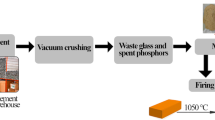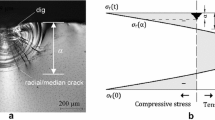Abstract
This study examined the usability of thin plates cut from rocks of volcanic origin as new decorative indoor and outdoor coating material when used instead of ceramic saddle. The study examined the basic material characterization of andesites and the glazability of andesites with glaze coating materials containing boron minerals. The series of characterization tests were conducted on andesite samples. Then, the samples were applied glaze for trial purposes. Analysis indicated that the andesite samples consisted of sanidine, mica and pyroxene minerals and its apparent porosity, density, water absorption, salt crystallization resistance, compressive strength, frost after compressive strength, bending strength and impact resistance values were 15.75 %, 2,640 kg/m3, 7.41 %, 1.06 %, 47.03 MPa, 45.25 MPa, 10.16 MPa and 9.87 kPa respectively. In heat microscope measurements, maximum sintering was recorded at 1,182 °C. Linear expansion coefficient (α) of the andesite at 400 °C was 4.69 × 10−6 K−1. Firing performed by using the prepared glaze recipe at approximately 1,055 and 1,000 °C produced good results in terms of body-glaze harmony.











Similar content being viewed by others
References
Sariisik G (2010) Investigation of glazability of Afyon–Iscehisar volcanic rocks and glaze materials. Ph.D. thesis, S.U., Konya, Turkey
Sariisik A, Sariisik G, Şentürk A (2011) Applications of glaze and decor on dimensioned andesites used in construction sector. Constr Build Mater 25:3694–3702
Şentürk A, Gündüz L, Tosun YI, Sariisik A (1996) Marble technology. Tugra Press, Isparta (in Turkish)
Kulaksız S (2007) Natural stone (marble) mining and processing technologies. TMMOB Chamber of Mining Engineers, Ankara (in Turkish)
Williams H, Turner FJ, Gilbert CM (1982) Petrography: an introduction to the study of rocks in thin sections. WH Freeman and Company, New York
Koca MY, Yavuz AB, Kıncal C (2001) The usage of andesitic rocks as a coating purpose in Bergama (İzmir)—case study. In: Turkey III. Marble symposium proceedings
Aydar E, Bayhan H, Gourgaud A (1998) Koroglu caldera, mid-west Anatolia, Turkey: volcanological and magmatological evolution. J Volcanol Geoth Res 85:83–98
Aydar E, Bayhan H, Gourgaud A (2003) The lamprophyres of Afyon stratovolcano, western Anatolia, Turkey: description and genesis. CR Geosci 335:279–288
Köktürk U (2002) Endüstriyel Hammaddeler. Dokuz Eylül Üniversitesi Mühendislik Fakültesi Yayınları, İzmir, pp 20–30
Kartal A, Gürtekin H (2002) Effects of various boron raw materials on melting of glaze. In: 1st Boron symposium proceedings
Kartal A (1998) Glaze and ceramic technique. Çizgi Pres
Karakaya M (2007) Seramik hammaddelerinin mineralojisi, kimyasi ve tüflerin değerlendirilmesi. IV. Uluslararası Katılımlı Seramik, Cam, Emaye, Sır ve Boya Semineri (SERES’07). Bildiriler Kitabı, pp 230–240
Köseoğlu K, Bayça SU (2008) Kolemanit ve üleksit konsantratör atığı katkısı ile daha düşük sicaklıkta mavi renkli sır üretimi, VII. Uluslararası Katılımlı Seramik Kongresi, pp 729–737
Çetin O, Çiğdemir G, Kara A, Kara F (2004) Porselen karo bünyelere borik asit ilavesinin etkileri. Seramik Araştırma Merkezi, Eskişehir, Proje nihai raporu, pp 10–29
Kayacı K, Küçüker AS, Köstebekçi N, Uzun M, Kara A (2008) Mermer Kesim ve Frit Atıklarının Porselen Karo Bünyelerinde Beraber Kullanımı. VII. Uluslararası Katılımlı Seramik Kongresi, pp 208–219
Dondi M, Biasini V, Guarini G, Raimondo M, Argnani A, Di Primio S (2002) The influence of magnesium silicates on technological behaviour of porcelain stoneware tiles. Key Eng Mater 206:1795–1798
Çetin S (2005) The usage of frit content of basaltic tuff on ceramic wall and floor tiles glazes, investigation of its chemical and psychical properties. M.Sc. thesis, Ç.U., Adana, Turkey
Duran E, Demir L, Gönenç S (2002) Searching artistic effects on the red lead, boron and alkaline glaze compositions (1000°C–1200°C) of the andesites found in Isparta region. In: 2nd International symposium on terracotta, pp 340–348
Dvorkin LI, Galushko IK (1969) Glazes based on basalts. Glass Ceram 26:679–691
Ercenk E, Bayrak G, Şen U, Yılmaz Ş (2006) The use of volcanic basalt rocks and ceramics industry. In: 6th International ceramics congress participation, pp 37–42
Gal’perina MK, Mitrokhin VS, Mumladze NA (1981) Coloured glazes based on andesite. Glass Ceram 38:528–530
Gal’perina MK, Mumladze NA (1980) Zircon-free opacified coloured glazes based on andesite. Glass Ceram 37:197–199
TS EN 1936 (2007) Natural stone test methods: determination of real density and apparent density, and of total and open porosity. Turkish Standards Institute, Ankara
TS EN 13755 (2003) Natural stone test methods—determination of water absorption at atmospheric pressure. Turkish Standards Institute, Ankara
TS EN 12370 (2001) Natural stone test methods—determination of resistance to salt crystallization. Turkish Standards Institute, Ankara
TS EN 1926 (1999) Natural stone test methods—determination of compressive strength. Turkish Standards Institute, Ankara
TS EN 12371 (2011) Natural stone test methods—determination of frost resistance. Turkish Standards Institute, Ankara
TS EN 13161 (2009) Natural stone test methods—determination of flexural strength under constant moment. Turkish Standards Institute, Ankara
Sariisik G (2012) Determining performance of marble finished products on their usage areas by a new impact-resistance test method. J Test Eval 40(5):1–7
Le Bas Le MJ, Maitre RW, Streckeisen A, Zanettin B (1986) A chemical classification of volcanic rocks based on total alkali–silica diagram. J Petrol 27:745–750
Bernardo E, Castellan R, Hreglich S, Lancellotti I (2006) Sintered sanidine glass–ceramics from industrial wastes. J Eur Ceram Soc 26:3335–3341
Acknowledgments
This study was financially supported by the TÜBİTAK-1001 Project (Project No: 108M027). We would like to thank TÜBİTAK for its valuable contributions.
Author information
Authors and Affiliations
Corresponding author
Rights and permissions
About this article
Cite this article
Sarıışık, G., Sarıışık, A. & Gökay, M.K. Investigation the glazability of dimension andesites with glaze coating materials containing boron minerals in construction sector. Mater Struct 46, 1507–1517 (2013). https://doi.org/10.1617/s11527-012-9992-1
Received:
Accepted:
Published:
Issue Date:
DOI: https://doi.org/10.1617/s11527-012-9992-1




